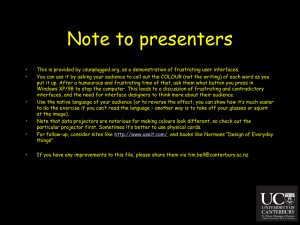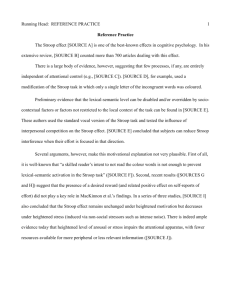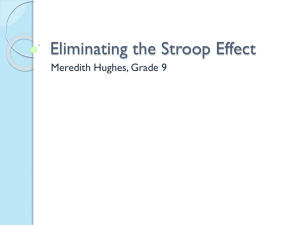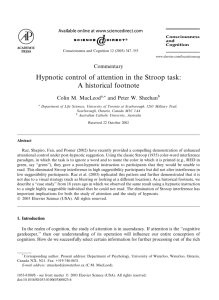REACTION TIME - The Open University
advertisement
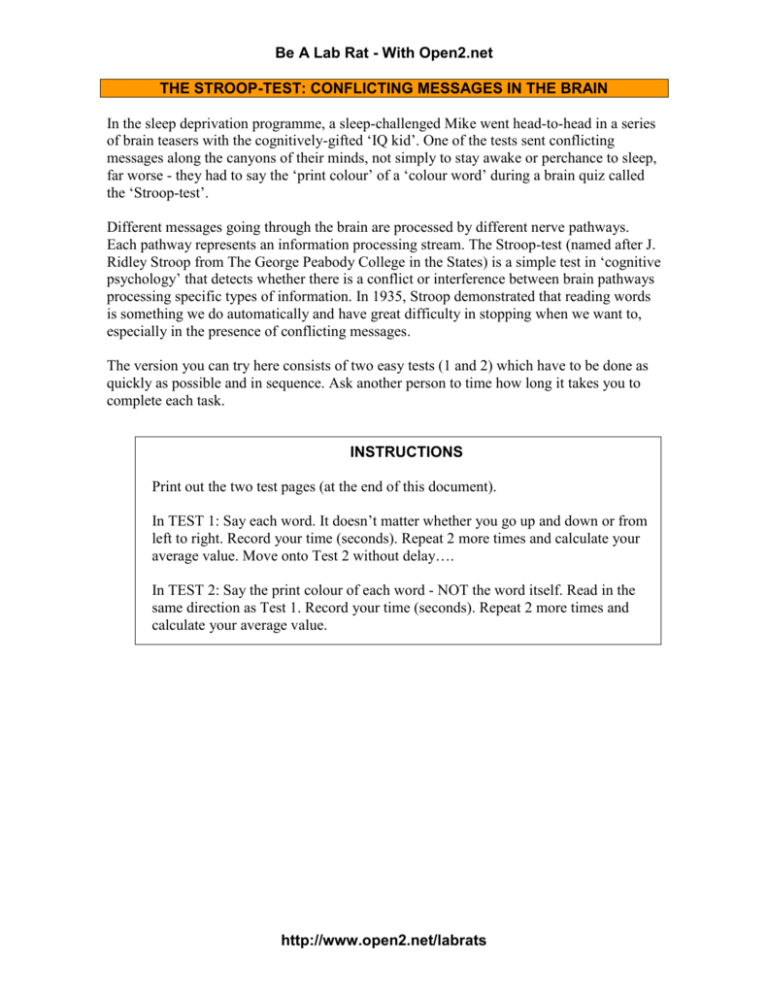
Be A Lab Rat - With Open2.net THE STROOP-TEST: CONFLICTING MESSAGES IN THE BRAIN In the sleep deprivation programme, a sleep-challenged Mike went head-to-head in a series of brain teasers with the cognitively-gifted ‘IQ kid’. One of the tests sent conflicting messages along the canyons of their minds, not simply to stay awake or perchance to sleep, far worse - they had to say the ‘print colour’ of a ‘colour word’ during a brain quiz called the ‘Stroop-test’. Different messages going through the brain are processed by different nerve pathways. Each pathway represents an information processing stream. The Stroop-test (named after J. Ridley Stroop from The George Peabody College in the States) is a simple test in ‘cognitive psychology’ that detects whether there is a conflict or interference between brain pathways processing specific types of information. In 1935, Stroop demonstrated that reading words is something we do automatically and have great difficulty in stopping when we want to, especially in the presence of conflicting messages. The version you can try here consists of two easy tests (1 and 2) which have to be done as quickly as possible and in sequence. Ask another person to time how long it takes you to complete each task. INSTRUCTIONS Print out the two test pages (at the end of this document). In TEST 1: Say each word. It doesn’t matter whether you go up and down or from left to right. Record your time (seconds). Repeat 2 more times and calculate your average value. Move onto Test 2 without delay…. In TEST 2: Say the print colour of each word - NOT the word itself. Read in the same direction as Test 1. Record your time (seconds). Repeat 2 more times and calculate your average value. http://www.open2.net/labrats Be A Lab Rat - With Open2.net How Long Did You Take? How long did Test 1 take? Since you probably had no problems saying the words, I bet it was quite fast… However, most people find Test 2 difficult. In general, your time score on Test 2 should be approximately double that for Test 1. The graph below shows a distribution of Test 2 results from a large number of people – how does your time compare? I imagine you could feel the ‘conflict’ described by Stroop as you performed Test 2. Don’t worry if you were unusually fast or, like me, very slow - Stroop-test results vary widely between individuals. % people tested 30 Distribution of Average Test 2 Times 20 + 36+ 30-35 25-30 20-25 15-20 10-15 5-10 0 0-5 10 Time interval (seconds) Curiosity Zone – Time To Experiment Now you’ve had a go, why not try the Stroop-test again with other people: on people of different ages when you’re alert or when you’re tired when you’re happy or when you’re sad on people of different sexes with the page for Test 2 lying ‘upside down’ on people from different cultures (possibly who don’t read English) Finally, does practice improve your ‘Stroop-ability’? A Mouth-Watering Stroop-Test… Food Forethought:A recent study by Brody* et al. (2004) shows that when people with low blood-sugar levels are tested with a ‘food version’ of the Stroop test (where ‘food’ words are interspersed among control ‘non-food’ words) that the reaction time increases when ‘food’ words are present. The researchers concluded that the increased reaction time is due to motivational attention selectively dwelling on food-relevant stimuli… surprise, surprise! Similar to crossing the Sahara, preoccupied with the famous image of an ice cold beer in Alexandria. * Reference: Brody S, Keller U, Degen L, Cox DJ, Schachinger H. Selective processing of food words during insulin-induced hypoglycemia in healthy humans. Psychopharmacology (Berl). Jan 15. 2004 http://www.open2.net/labrats Be A Lab Rat - With Open2.net The Science Behind The Stroop Test The Stroop ‘colour-word’ test requires subjects to name the ‘ink colour’ of a ‘colour word’. The colour word is either the ‘same as’ (congruent with) or ‘not the same as’ (incongruent with) the ink colour (Stroop*, 1935). For example, when the colour word – RED - is the same as the print colour – RED - the reaction time for naming the colour print is fast, compared to a control test. This is called ‘Stroop facilitation’. However, when the colour word – BLUE - is not the same as with the print colour – RED - the reaction time for naming the colour greatly increases and most people slow down and take longer to say the word correctly. When you try to say the print colour, it becomes very difficult to avoid reading the word. If the two bits of information conflict, your brain struggles to work out what the correct answer is, and it takes longer. This is commonly referred to as ‘Stroop interference’. The vast majority of research regarding the Stroop test has focused on why ‘facilitation’ and ‘interference’ occur and the underlying brain mechanisms. Such research has primarily examined sex, age, brain hemisphere and language differences between individuals. The test is very sensitive to subtle changes in brain function that affect attention – so lack of sleep, fatigue and minor brain injury have all been found to increase the time it takes to do the test. The test has also been used on Everest expeditions to see how high-altitude affects the Stroop response in climbers. More recently Stroop differences related to cognitive abilities (e.g., working memory, spatial reasoning etc) have been much researched in both health and disease. You can read Stroop’s original paper by visiting: http://psychclassics.yorku.ca/Stroop/ (The BBC and the Open University are not responsible for the contents of external websites) Curiosity Zone – Time For Some Answers Did you try out some of the Curiosity Zone challenges? Here’s what scientific research has found: The older you are the higher your reaction time for Test 2. Reaction times generally increase with age When you are alert, Test 2 is much easier. Attentional mechanisms in the brain can partially compensate for interference. When you’re moody your reaction time for Test 2 is likely to increase (a stroppy Strooper?) Mood can affect cognitive mechanisms, especially attention. On people of different sexes… you tell me! With Test 2 lying ‘upside down’ your reaction time should decrease. Partial dissociation of word meaning (semantics) helps to reduce interference. If you don’t understand the written words (semantics) then there won’t be a conflict, so there won’t be a problem. Finally, Stroopping can be learnt – so hard practice will help! * Reference: Stroop J.R. (1935) Studies of interference in serial verbal reactions. Journal of Experimental Psychology: 18: 643-662. http://www.open2.net/labrats Be A Lab Rat - With Open2.net Test 1 GREEN PURPLE BLUE RED GREEN PINK ORANGE BLUE PURPLE YELLOW GREY RED GREEN ORANGE BLACK BLUE RED YELLOW PINK Time Taken to read list: a) sec. b) sec. c) Calculate average value [(a+b+c+d+e) divided by 5] = sec. d) sec. for Test 1. http://www.open2.net/labrats sec. & e) sec. Be A Lab Rat - With Open2.net Test 2 GREEN WHITE PURPLE BLUE RED GREEN PINK ORANGE PURPLE YELLOW GREY RED GREEN ORANGE BLACK BLUE RED WHITE YELLOW Time Taken to read list: a) sec. b) sec. c) Calculate average value [(a+b+c+d+e) divided by 5] = sec. d) sec. for Test 2. http://www.open2.net/labrats sec. & e) sec.
